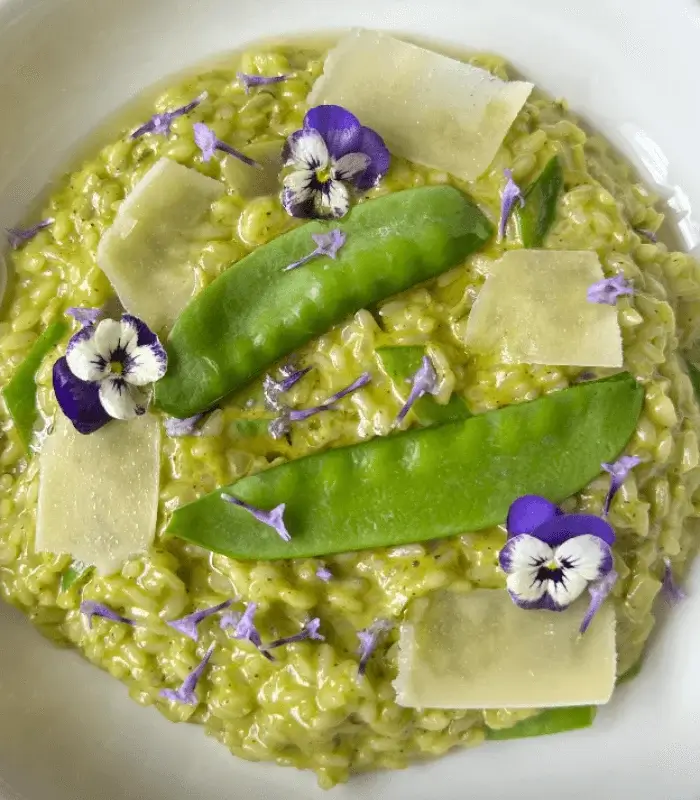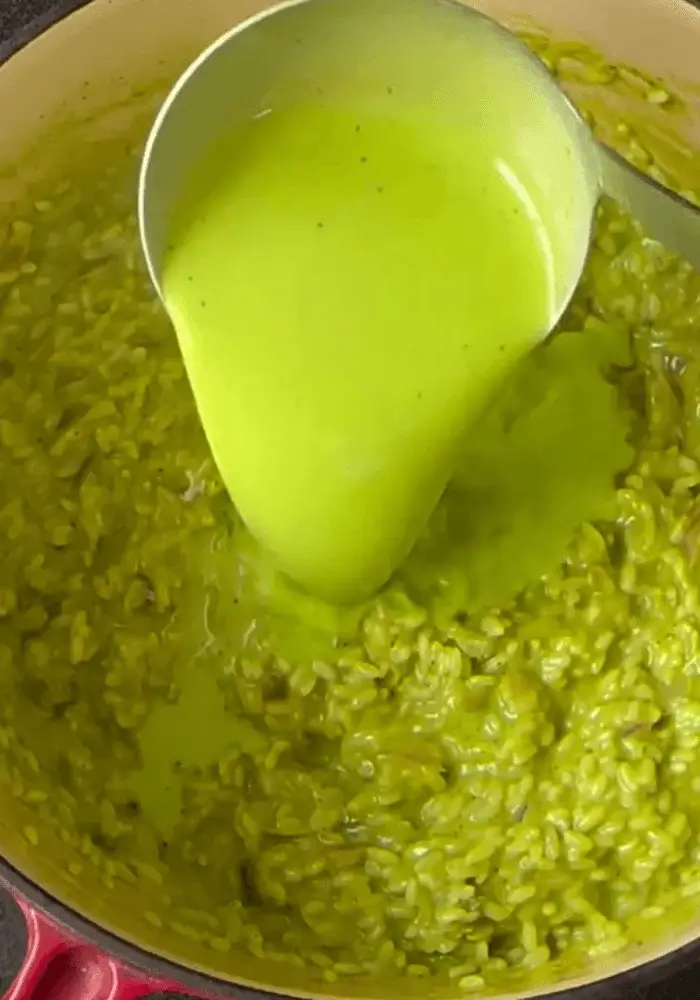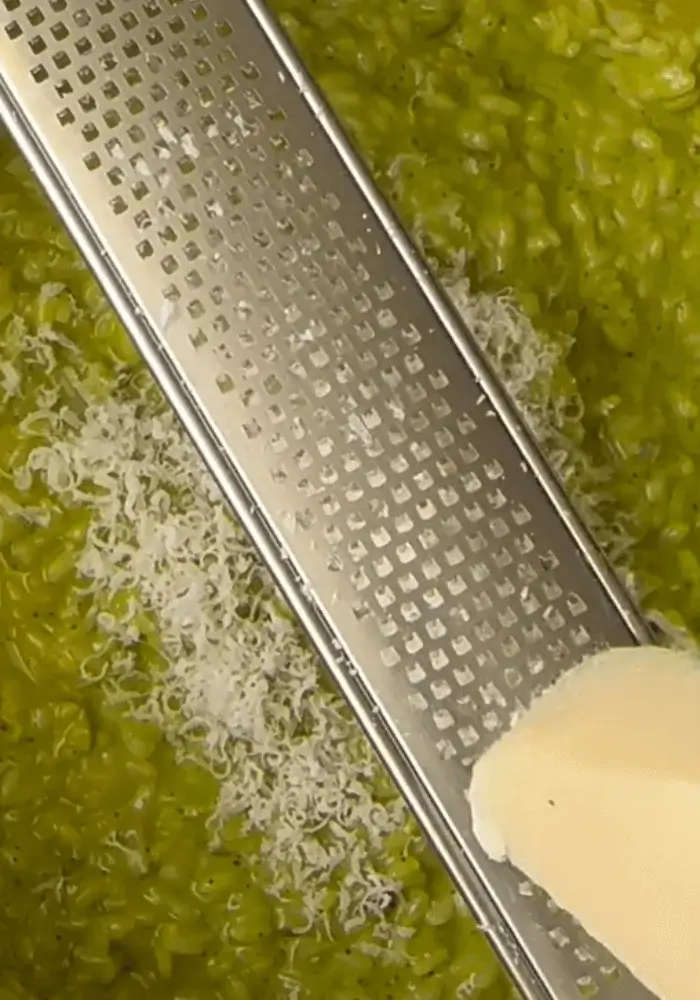Kale and Leek Risotto
We may earn a commission from recommended products, at no extra cost to you. See Disclosure.
INGREDIENTS
- 2 tablespoons olive oil, divided
- 1 tablespoon unsalted butter
- 1 cup/200 grams Arborio or round rice
- 1 cup/240 milliliters dry white wine
- 1 small red onion, finely chopped
- 3 fresh sage leaves, chopped
- ¾ cup/75 grams grated Parmesan cheese, plus more for serving
- 10 snow pea pods
- 4 cups/120 grams kale leaves, chopped
- 2 medium leeks, white and light green parts only, sliced
- 1 cup/240 milliliters heavy cream
- 1 ½ cups/360 milliliters water
- Salt and freshly ground black pepper, to taste
- Edible flowers, for garnish
INSTRUCTIONS
- In a medium saucepan, heat 2 tablespoons of olive oil over medium heat. Add the kale and leeks and cook for 4 to 5 minutes, until the leeks are soft. Season with salt and pepper. Add the water and heavy cream and bring to a boil. Remove from the heat and transfer to a food processor. Blend until smooth, then strain through a fine mesh sieve. Reserve the liquid for the risotto. (You can save the purée for another use, such as a savory tart filling.)
- In a wide saucepan, heat 2 tablespoons of olive oil and 1 tablespoon of butter over medium heat. Add the chopped red onion and cook until soft, about 5 minutes. Stir in the sage and rice and toast for 1 to 2 minutes until the grains are translucent at the edges. Pour in the white wine and stir until it is fully absorbed.
- Begin adding the strained kale-leek liquid, about 1/2 cup at a time, stirring constantly and allowing the rice to absorb the liquid before adding more. Continue until the rice is tender and creamy, about 20 minutes total. Stir in the Parmesan and season to taste with salt and pepper.
- Blanch the snow peas in boiling water for 2 minutes, then transfer to a bowl of ice water. Slice into small pieces and fold into the risotto.
- Serve hot, drizzled with olive oil and topped with shaved Parmesan, snow peas, and edible flowers.

FAQ
What is the best type of rice to use for risotto?
The best type of rice to use for risotto is Arborio rice, which is a short-grain Italian variety known for its high starch content. This starch is essential for creating the creamy texture that defines a proper risotto. Other acceptable varieties include Carnaroli and Vialone Nano, both of which also have a high starch content and retain their shape well during cooking. Long-grain rice varieties, such as jasmine or basmati, do not release enough starch and will result in a dish that lacks the signature creaminess of leek risotto.
How do I store and reheat leftover risotto?
To store leftover risotto, transfer it to an airtight container and refrigerate for up to 3 days. When reheating, add a few tablespoons of water, broth, or plant-based milk to loosen the texture. Warm it slowly over low heat on the stovetop, stirring frequently to prevent sticking. You can also microwave it in short bursts, stirring in between, but this may result in a less creamy consistency. Avoid freezing risotto, as the rice can become mushy and the texture grainy when thawed. For best results, enjoy leftovers within a couple of days of preparation.

Can I make leek risotto without wine?
You can make leek risotto without wine. While white wine adds acidity and depth of flavor to the dish, it is not essential for the risotto to turn out well. You can substitute an equal amount of vegetable or chicken broth, or even water, in place of the wine. A small splash of lemon juice or white wine vinegar can also help replicate the brightness wine adds. The key to a successful leek risotto lies in gradually adding hot liquid and stirring continuously, allowing the rice to absorb the flavors and release its starch for a creamy consistency.
How do I keep the risotto from becoming too thick or dry?
To prevent the risotto from becoming too thick or dry, it is important to maintain a steady supply of warm liquid during cooking. Always keep your broth or other cooking liquid simmering on the stove so it is ready to add in small increments. Stir the risotto frequently but not constantly; this helps release the rice’s starch without overworking it. If your leek risotto begins to look too thick, add a bit more hot liquid and stir to loosen it. Just before serving, check the consistency—it should flow slightly on the plate and not hold a rigid shape.
Can I substitute spinach or chard for kale?
You can substitute spinach or chard for kale, but be aware of differences in texture and cooking time. Spinach cooks much faster and has a softer consistency, so it should be added later in the cooking process to avoid overcooking. Chard has a similar texture to kale and works well when sautéed with leeks and blended into the base. Both substitutions will yield a slightly different flavor profile, with spinach offering a milder taste and chard contributing an earthier note. Regardless of the substitution, the method of puréeing and straining can remain the same.

Is it necessary to strain the vegetable purée?
Straining the vegetable purée is not strictly necessary but is highly recommended for achieving a refined texture. The straining process removes any fibrous bits from the kale and leeks, ensuring the liquid used to cook the rice is smooth and easy to incorporate. If you skip this step, the risotto may have a more rustic texture, which some people may prefer. However, if you’re aiming for a restaurant-style leek risotto with a velvety consistency, straining is worth the extra effort. Use a fine mesh sieve or cheesecloth for best results, and press to extract as much liquid as possible.
How can I make leek risotto vegan?
To make leek risotto vegan, replace the butter with olive oil or a plant-based margarine, use a vegan-friendly white wine (optional), and substitute the heavy cream with an unsweetened plant-based cream such as oat, soy, or cashew cream. Replace Parmesan cheese with a vegan hard cheese or a homemade blend of nutritional yeast, ground cashews, and salt. Ensure your broth is vegetable-based. The rest of the leek risotto preparation remains the same. The key to a creamy vegan risotto lies in frequent stirring and adding liquid gradually, so the rice releases its natural starch to create a rich texture without dairy.
What proteins pair well with leek risotto?
Leek risotto pairs well with a variety of proteins depending on the occasion and dietary preference. For a light and elegant dish, serve it alongside seared scallops, shrimp, or poached white fish such as cod or halibut. For a more robust meal, grilled chicken, pan-fried pork chops, or roasted duck complement the savory notes of the leeks and Parmesan. Vegetarian options include roasted mushrooms, crispy tofu, or a soft-boiled egg. The mild flavor of leek risotto makes it a versatile base that can balance both delicate and bold proteins without overwhelming the dish’s natural creaminess.
Can I prepare the risotto ahead of time?
Leek risotto is best served immediately after cooking, but you can prepare it partially ahead of time using the restaurant technique called “par-cooking.” Cook the rice about 70% of the way, then spread it on a baking sheet to cool quickly. When ready to serve, reheat it with the reserved vegetable liquid or broth, stirring until it reaches the desired texture and is fully cooked. This method helps maintain the creamy consistency without overcooking the rice. Fully cooked risotto does not reheat well for serving at its peak, as the texture may become gluey or overly thick.

